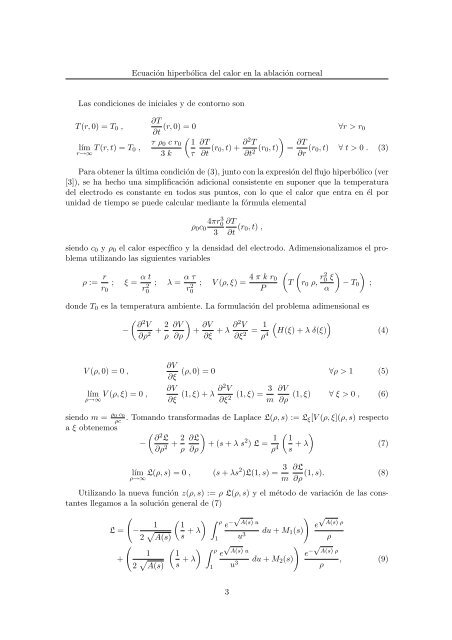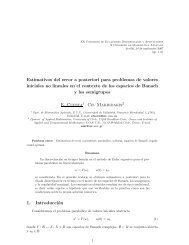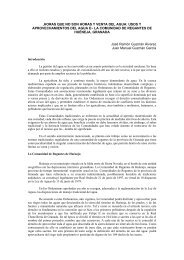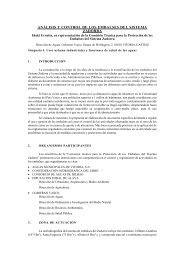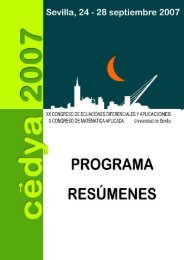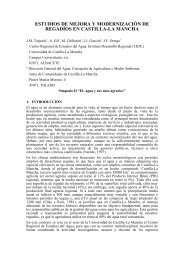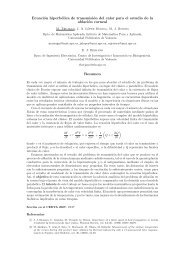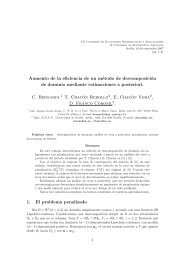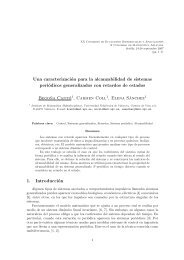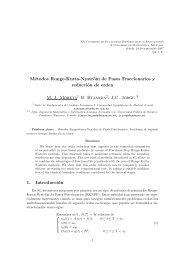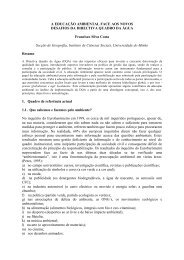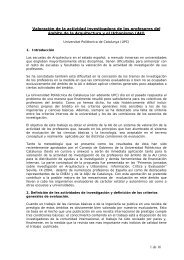Ecuación hiperbólica de transmisión del calor para el estudio de la ...
Ecuación hiperbólica de transmisión del calor para el estudio de la ...
Ecuación hiperbólica de transmisión del calor para el estudio de la ...
Create successful ePaper yourself
Turn your PDF publications into a flip-book with our unique Google optimized e-Paper software.
<strong>Ecuación</strong> <strong>hiperbólica</strong> <strong>de</strong>l <strong>calor</strong> en <strong>la</strong> ab<strong>la</strong>ción corneal<br />
Las condiciones <strong>de</strong> iniciales y <strong>de</strong> contorno son<br />
T (r, 0) = T0 ,<br />
lím<br />
r→∞ T (r, t) = T0 ,<br />
∂T<br />
(r, 0) = 0 ∀r > r0<br />
∂t<br />
<br />
τ ρ0 c r0 1 ∂T<br />
3 k τ ∂t (r0, t) + ∂2T ∂t2 (r0,<br />
<br />
t) = ∂T<br />
∂r (r0, t) ∀ t > 0 . (3)<br />
Para obtener <strong>la</strong> última condición <strong>de</strong> (3), junto con <strong>la</strong> expresión <strong>de</strong>l flujo hiperbólico (ver<br />
[3]), se ha hecho una simplificación adicional consistente en suponer que <strong>la</strong> temperatura<br />
<strong>de</strong>l <strong>el</strong>ectrodo es constante en todos sus puntos, con lo que <strong>el</strong> <strong>calor</strong> que entra en él por<br />
unidad <strong>de</strong> tiempo se pue<strong>de</strong> calcu<strong>la</strong>r mediante <strong>la</strong> fórmu<strong>la</strong> <strong>el</strong>emental<br />
4πr<br />
ρ0c0<br />
3 0 ∂T<br />
3 ∂t (r0, t) ,<br />
siendo c0 y ρ0 <strong>el</strong> <strong>calor</strong> específico y <strong>la</strong> <strong>de</strong>nsidad <strong>de</strong>l <strong>el</strong>ectrodo. Adimensionalizamos <strong>el</strong> problema<br />
utilizando <strong>la</strong>s siguientes variables<br />
ρ := r<br />
r0<br />
; ξ =<br />
α t<br />
r 2 0<br />
; λ =<br />
α τ<br />
r 2 0<br />
; V (ρ, ξ) =<br />
4 π k r0<br />
P<br />
<br />
T r0 ρ, r2 0 ξ<br />
<br />
− T0<br />
α<br />
don<strong>de</strong> T0 es <strong>la</strong> temperatura ambiente. La formu<strong>la</strong>ción <strong>de</strong>l problema adimensional es<br />
V (ρ, 0) = 0 ,<br />
<br />
∂2V 2<br />
− +<br />
∂ρ2 ρ<br />
lím V (ρ, ξ) = 0 ,<br />
ρ→∞<br />
<br />
∂V<br />
+<br />
∂ρ<br />
∂V<br />
∂ξ + λ ∂2V 1<br />
=<br />
∂ξ2 ρ4 <br />
<br />
H(ξ) + λ δ(ξ)<br />
∂V<br />
(ρ, 0) = 0<br />
∂ξ<br />
∀ρ > 1 (5)<br />
∂V<br />
∂ξ (1, ξ) + λ ∂2V ∂ξ2 3 ∂V<br />
(1, ξ) = (1, ξ)<br />
m ∂ρ<br />
∀ ξ > 0 , (6)<br />
siendo m = ρ0 c0<br />
ρc . Tomando transformadas <strong>de</strong> Lap<strong>la</strong>ce L(ρ, s) := Lξ[V (ρ, ξ](ρ, s) respecto<br />
a ξ obtenemos<br />
<br />
∂2L 2<br />
− +<br />
∂ρ2 ρ<br />
<br />
∂L<br />
+ (s + λ s<br />
∂ρ<br />
2 ) L = 1<br />
ρ4 <br />
1<br />
+ λ<br />
s<br />
lím<br />
ρ→∞ L(ρ, s) = 0 , (s + λs2 )L(1, s) = 3<br />
m<br />
;<br />
(4)<br />
(7)<br />
∂L<br />
(1, s). (8)<br />
∂ρ<br />
Utilizando <strong>la</strong> nueva función z(ρ, s) := ρ L(ρ, s) y <strong>el</strong> método <strong>de</strong> variación <strong>de</strong> <strong>la</strong>s constantes<br />
llegamos a <strong>la</strong> solución general <strong>de</strong> (7)<br />
√<br />
A(s) ρ e<br />
ρ<br />
<br />
1<br />
L = −<br />
2 ρ 1 e<br />
+ λ<br />
A(s) s 1<br />
−√A(s) u<br />
u3 <br />
du + M1(s)<br />
<br />
1<br />
+<br />
2 √<br />
ρ A(s) u<br />
1 e<br />
+ λ<br />
A(s) s u3 <br />
e<br />
du + M2(s)<br />
−√A(s) ρ<br />
, (9)<br />
ρ<br />
1<br />
3


